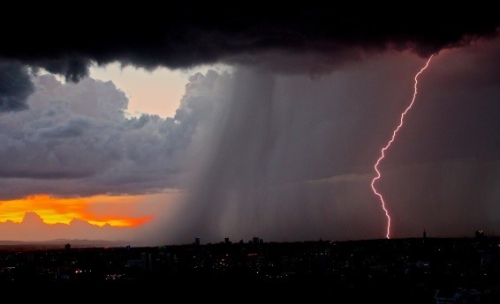Previous studies have indicated a worldwide increasing trend of intense precipitation events under the influence of global warming. Heavy precipitation events increase the risk of flooding, exerting devastating effects on human society and the environment, especially for metropolises with dense populations. As one of the largest cities in the world, Beijing is highly vulnerable to increasingly frequent and intense precipitation events, such as the torrential rain event on 21 July 2012, when the city encountered its heaviest rainfall in the past few decades with a record-breaking amount of 460 mm in 18 hours. Scientists have found that short-duration rainfall (SDR) events (a rainfall event of 6 hours or less in duration) dominate the total rainfall amount over Beijing in summer, and the rainfall amount of SDR events has increased significantly in recent decades. Thus, it is of great significance to provide accurate predictions of SDR events—something that remains a considerable challenge for scientists and forecasters.

Lightning can be used to predict approaching rainstorms. (Image by699pic.com, ID: 500032078)
Scientists have noticed and taken advantage of lightning to predict approaching rainstorms, but there are few potent prediction or warning methods available for the rainfall caused by such rainstorms—especially SDR events. After studying the relationship between lightning and precipitation over Beijing during the warm seasons of 2006 and 2007, scientists from the Institute of Atmospheric Physics, Chinese Academy of Sciences (WU Fan and CUI Xiaopeng) and their co-author (Da-lin ZHANG, University of Maryland) developed a lightning-based nowcast-warning approach for SDR events, and then tested its performance over the Beijing Metropolitan Region (BMR). Their findings were recently published in Atmospheric Research. The new approach uses sharp increasing rates of lightning flashes, termed lightning jumps, observed by lightning location systems, to provide early warnings for SDR events. Different from previous warning approaches for other severe types of weather caused by rainstorms (e.g., tornadoes, hail and wind gusts), in this approach, a rapid rise in the rainfall rate (referred to as a rainfall jump) in an SDR event is chosen as the warning target. The nowcast-warning approach proposed in this study was designed for two types of SDR events—namely, those with moderate and intense rainfall rates.
To provide more accurate predictions of SDR events, the authors developed graded nowcast-warning models by changing the parameters in the lightning jump algorithm based on their new approach. These models can issue different signals based on the intensity of the lightning jump to improve the nowcast-warning performance. The models utilize low-grade warning signals to capture as many SDR events as possible, and take advantage of high-grade warning signals to improve the warning reliability. To verify the performance of the models, a total of 870 moderate and 452 intense SDR events over the BMR were selected. The results showed encouraging model performance. The warning models provided successful early warnings for 67.8% (87.0%) of the moderate (intense) SDR events, with false alarms of 27.0% (22.2%). In addition, the models provided a longer average warning time for the intense SDR events (52.0 minutes) than the moderate ones (36.7 minutes).
Finally, the authors further validated the models using three typical heavy-rain-producing storms that were independent from those used to develop the models. Results showed that the models present an encouraging warning capability for SDR events from regional to meso-γ scales. “Our approach provides a new perspective on predicting SDR events,” says CUI, the corresponding author of the study.
Citation:
Fan Wu, Xiaopeng Cui, Da-Lin Zhang, 2018, A Lightning-Based Nowcast-Warning Approach for Short-Duration Rainfall Events: Development and Testing over Beijing During the Warm Seasons of 2006–2007, Atmospheric Research, DOI:10.1016/j.atmosres.2018.02.003, in press. https://www.sciencedirect.com/science/article/pii/S0169809517311936
Media Contact: Ms. LIN Zheng, jennylin@mail.iap.ac.cn
